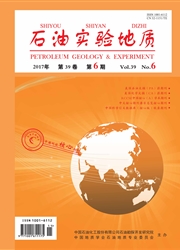

 中文摘要:
中文摘要:
通过对鲁西地区的野外地质踏勘,结合对济阳坳陷地球物理资料的解释,对鲁西地区的伸展构造特征进行系统研究,并对其发育演化进行了地质建模。在此基础上,运用基于有限元方法的Ansys12.0软件对研究区晚中生代—古近纪伸展构造的发展演化进行了三维构造应力场数值模拟,取得了与实际地质情况较高的吻合度。模拟结果显示,晚中生代—古近纪,鲁西地区构造应力场的强度经历了强—较强—弱的演化过程,最大主应力方向发生了从NW-SE到NWW-SEE,再到NE-SW的重大转变,其中古新世—早始新世为构造应力场变革转型的过渡期,中始新世—渐新世为鲁西隆起与济阳坳陷分异演化的重要阶段。此伸展构造演化对坳陷区油气的聚集及隆起区金属矿产的富集具有重要的控制作用,其动力来源主要受控于区域上太平洋板块向欧亚板块俯冲方式的转变、郯庐等边界大断裂走滑活动的变化以及垂向上地幔物质的上涌强度等关键因素。
 英文摘要:
英文摘要:
Extensional tectonics in the West Shandong Uplift were examined and geological models were established using field geological survey data of the western Shandong and the geophysical data of the Jiyang Depression. Based on a finite element method,we adopted the Ansys12. 0 software to carry out a 3D tectonic stress field numerical simulation of the extensional tectonic evolution of the study area from the Late Mesozoic to Paleogene,which fit well with the actual geological conditions. The results indicated that the tectonic stress field evolved from strong to weak from the Late Mesozoic to Paleogene,and the maximum principal stress axis transferred from NW- SE to NWW- SEE,and then to NE- SW,which was a major shift. Paleocene- Early Eocene was a transitional period with its stretching orientation transformed from NE- SW to NS,and Eocene- Oligocene was a significant phase for uplift-depression differentiation when the West Shandong Uplift and the Jiyang Depression became separated and evolved separately. This evolution regularity had an important control on the migration and accumulation of oil and gas in the Jiyang Depression and the enrichment of metallic minerals in the West Shandong Uplift. The essential factors leading to the tectonic evolution were the changes of the Pacific Plate subduction,the strike slipping motion along the major boundary fractures,and the magma under plating.
 同期刊论文项目
同期刊论文项目
 同项目期刊论文
同项目期刊论文
 期刊信息
期刊信息
